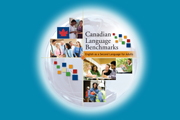My PBLA
Introduction
In your English as a Second Language (ESL) class, you are learning English for living, study and working in Canada.
Your teachers use Portfolio Based Language Assessment (PBLA) as part of the program.
In PBLA, your teachers use “real world tasks” to help you learn.
“Real world tasks” are the things you need to do to live, study and work in Canada. This means that you learn English by practising things you need to do everyday, such as
- talking to your child’s teacher
- making an appointment
- going to the grocery store
- asking for help
- taking public transport
- reading job advertisements
- applying for a job
What is PBLA?
The purpose of your portfolio/binder
How PBLA can help you in your daily life
Testimonials
Listening is a very important language skill but a very difficult one.
In our daily lives:
- Speakers speak at different speeds, with different accents.
- They use words that we have often never heard.
- In some cases, such as public transport announcements we only hear the announcement once.
In the classroom:
- Listening is easier.
- Teachers are trained to speak at a speed that their students are comfortable with.
- The subjects they talk about are ones that are familiar to their students.
- They check constantly that students understand what they are saying.
- As a student, you should feel comfortable asking your teacher to repeat what they are saying or to explain what they mean.
This section of My PBLA gives you:
- tips to help you improve your listening, and
- activities that you can use to practice.
Remember, this is your PBLA. You can choose which practice activities you do. We suggest you:
- Explore this section.
- Listen to the audio and video clips that interest you.
- Play them more slowly sometimes.
- Play them as many times as you want.
- Start and stop them when you hear new words or you have difficulty understanding.
- Try some of the practice activities.
- Look at some of the links that we have provided.
Throughout this section you will find tips to help you improve your listening skills.
Canadian Language Benchmarks Listening Statements
There are 5 videos accompanied by listening activities (they are activity sets). Scroll down to access each activity set. Start by viewing the video once and then starting the activity. The instructions will be displayed once you start the activity.
Video 1: Getting the flu shot
Video 2: Telephone fraud
Video 3: The advantages of a Presto card
Video 4: Using a Presto card on the seamless regional transit system
Video 5: Parent Teacher Interviews
CCLB would like to thank Settlement.Org – Information Newcomers Can Trust for the use of their video in our activities. “English – Parent Teacher Interviews (Elementary School)” YouTube, uploaded by Settlement.Org – Information Newcomers Can Trust, 31 Oct. 2006, https://www.youtube.com/watch?v=ACZ1LGyGvHY.
My PBLA for those needing extra help with reading and writing
This section offers practice activities for people who need extra support for reading and writing. You will find four topics that offer several practice activities. If you need to enlarge the text on this page, you can find information on how to do this by clicking here.
Topics
- Winter activities
- Using community and recreational centres
- Going to the hospital
- Meeting your child’s teacher
You are the one who will choose the topics that interest you.
You don’t have to do everything.
Progress at your own pace.
Start by watching the introductory video and then scroll down the page to access each topic.
Introduction
Winter activities
Using community and recreational centres
Going to the hospital
Meeting your child’s teacher
On fraud:
- https://www.youtube.com/watch?v=MuHVjLNGDAQ Calgary police
- Canada Revenue Agency site https://www.canada.ca/en/revenue-agency/corporate/security/protect-yourself-against-fraud/sample-telephone-scam.html has other examples that you can listen to learn about scams and practice your listening. These are really useful because what is said is written and you can press the link to have it read out loud. A note though, the voice reading them is an electronic voice and does not sound like a real person.
- https://www.youtube.com/watch?v=Bfjd7RjoBSU
On education
Transcripts for PBLA videos in the 12 most common languages in Ontario:
1: What is PBLA? 2: The purpose of your portfolio/binder 3: How PBLA can help you in your daily life 4: Testimonials
Video 1: Getting the flu shot
Protect your family from the flu. Each year one in five Canadians gets the influenza virus, also known as the flu. The flu is much worse than a cold with symptoms like fever, cough, sore muscles and more. The flu vaccine can prevent these problems, but some people still choose not to get it. Why? Let’s look at three common myths.
Myth number one. I never get sick, so I don’t need a flu shot. That’s like saying, since you didn’t have a car accident last year you don’t need to wear a seatbelt. While it is unlikely that you will get the flu every year, when it does occur it can be very severe. The flu also spreads quickly, and you may catch it at school, at work or out in public. You could catch the flu and not even know it and pass it on to your family. When more people are vaccinated it’s harder for the flu to spread.
Myth number two. The flu shot doesn’t work. Each year experts develop new vaccines to protect against what they predict will be the most common flu strain. Most years the vaccine that they chose works very well. Although the flu vaccine is not always 100% effective, some protection is better than no protection and if vaccinated people still get the flu, it’s usually milder than in people who didn’t get the shot.
Myth number three: The flu shot will make me sick. The flu shot can cause a mild fever and a sore arm, but it can’t give you the flu. The particles in it are too weak. If you develop an infection soon after getting the vaccine you were going to get sick even if you did not get the shot.
Everyone over six months should get the flu shot every year, especially pregnant and breastfeeding women, parents, grandparents and anyone who cares for children. The flu shot is your family’s best defense against the flu. Talk to your doctor, nurse, pharmacist, or Public Health Unit about the flu vaccine.
Video 2: Telephone fraud
Hello, I’m from the Canada Revenue Agency. You have not paid your taxes. If you don’t pay immediately, police will be coming to arrest you. You can pay right now and avoid any trouble. All we need is your credit card information.
Written text:
STOP
THINK
BE AWARE OF FRAUD
Report Fraud to the Canadian Anti-Fraud Centre: 1-888-495-8501
Video 3: The advantages of a Presto card
Presto is all you need to get to where you want to be. It’s convenient, easily available and simple to use. All you have to do is tap and go. Presto is reloadable and allows you to travel seamlessly within and between transit regions across the Greater Toronto – Hamilton area and Ottawa. Whether transferring between buses or trains, Presto is Ontario’s smart card; taking you anywhere and everywhere you need to be. With Presto you never line up to buy tokens or tickets. All you need is a single reloadable card. Using Presto is as easy as 1-2-3. Get it, load it, and tap on.
Step 1: Get your Presto card from prestocard.ca or at transit stations.
Step 2: Load your card at prestocard.ca, over the phone or at a Presto customer service outlet.
Step 3: Tap your card on to a Presto reader when boarding and the lowest possible fare is always automatically deducted. Presto also acts as your transfer. Tap your card when transferring between buses, trains or routes and the system will know you are transferring. It’s that easy. Presto is not only convenient it is also flexible when it comes to paying your fare. Either pay as you go, load a pass or autoload. It’s also secure and protects your balance, should you lose your card. Presto takes you further than you ever thought possible. Find out more about Presto at prestocard.ca
Presto tap into an easier commute.
Video 4: Using a Presto card on the seamless regional transit system
Presto is our seamless regional transit fare card system. It lets customers tap into an easier commute on any participating transit system in the Greater Toronto, and Hamilton or Ottawa areas. Presto is a little like that the coffee shop card you might use every day, and a little different too.
Here’s how they are alike.
- You can buy either one in person or online
- You can reload your card in person or remotely
- You can register your card to protect against loss or theft
- and when you use it, you present it to make your purchase.
Here’s how they’re different.
- A coffee shop card has to communicate with a central system to make sure you have enough money on your card. That takes a few seconds, maybe not long in a coffee shop, but an eternity for customers boarding transit. On the other hand, the Presto card is like an electronic purse carrying the balance you have available to spend on fares, but no personal information. When you tap the card on a bus or at the station, the system deducts your fare from the card balance in under a second and unlike the coffee shop card, the transit system doesn’t necessarily communicate every transaction immediately to a central computer.
And that leads to something you should know about loading your card online. It can take up to 24 hours for devices in the transit system to know you have reloaded. Take a bus, as an example. Once it leaves the station in the morning, it’s disconnected from the central system and can’t receive updates on who’s reloaded their cards online. The buses get this information at night when they come back to the station.
Want to learn more? Visit the Presto website at prestocard.ca. We’re always working to make Presto even easier and expanding the locations we serve.
If you don’t already use Presto, check it out to see how you can tap into an easier commute.
Video 5: Parent teacher interviews
Going to school, it’s an exciting time. There’s so much to do, so much to learn. So much for a child to cope with in a new country. This video is about one of the important ways, parents can help their child succeed in school.
“Okay, so, boys and girls I have a letter here that I’d like you to take home to your parents please. It invites your parents to come to our next parent teacher interview, okay? And it’s really important and I’d like to see each and everyone of them, all right? Now, parent teacher interviews…”
Once or twice a year, you will be asked to come to your child’s school to talk with the teacher. The letter will suggest a time, but it can be changed if it isn’t convenient for you. Watch for the invitation to what is called the parent teacher interview.
“Mom, dad, well the teachers – I don’t know but there’s a letter he gave me.” “What is it we are going to?” “Parent teacher interview. What’s that? What’s wrong?” “It might be a teacher wants to meet with us.” “Okay, what date?” “Okay, December 2nd. Let me write that down.” “Hello, welcome to Clark School. It’s nice that you could come tonight. We’ll just check the list. Oh yes, you’re with our interpreter and you are down in room four.” “Thank you.” “Nice to meet you, I am Melissa.” “Thank you.”
Meeting the teacher to talk about how your child is progressing may be a new experience for you but it is very important for your child’s success. Most parents are glad to come and hear how their child is getting along “And you’re in room 10.” “Okay.” “Down this way.” “Thank you.” “Jennifer, will reread words and her sentences….”
The interview only takes a few minutes and you can bring a friend to help with English if you wish.” “Your next step should be, does it sound right?” Some schools can even provide an interpreter.
“Welcome to the parent teacher interview. I just wanted to say that I’m very glad that you can make it here this evening. Now, Richard is a very strong student. You must be encouraging him quite a bit at home. That’s okay.” “Thank you very much.” “Just to give you an idea of what he’s been doing. Here’s an example of some of his earlier work. And if you take a look at what he’s been writing just recently you can see that he’s progressed quite a reasonable amount. Now, as you can see his sentences are a fair bit longer. His spelling and grammar are much improved too.” “In China, Richard loved to write stories. Yeah.” “ It’s funny that you mention that because actually when he first came here I asked him to write something in his first language.”” He put some English words there.” ”Yeah. That’s interesting.” “No, but that’s good. He put in what he knew and then everything else he didn’t, he worked on, you know.”
The teacher will tell you about your child’s progress and tell you how you can help at home. “That’s great” “That’s good.” “And, we’re very happy to hear that but we have a concern about the homework.” “Oh, okay” “So, oh, compared with being back in China we didn’t see Richard bring home a lot of homework.” “Right, that is understandable. What we normally like to do here is, we’ll start something off in class. That gives the students a chance to basically if they have any questions they wish to ask, you know they can ask myself.”
Teachers also want to know about your child’s first language skills and the things he likes to do at home. The teacher will also answer your questions about schoolwork, homework and relationships with other students. “We are worried about that if Richard is making new friends here.” “You know, I understand that’s a great concern to a lot of parents, especially you know when, especially since Richard’s new to the school but I guarantee you have nothing to worry about. Richard’s a great, sociable child. He’s very involved in the school community. Now do you have any other questions or concerns about Richard at school?” “Uh, are there any, uh program for Richard after school?” “Definitely there are lots of after school programs, do you know that you can take advantage of. There’s the soccer program. I know that you said Richard likes soccer.” “Mm, yeah.”
Meeting the teacher like this is a good opportunity to learn how well your child is doing. As a parent, it’s always wonderful to hear of your child’s progress but you should also listen carefully for suggestions on how your child can improve and how you can help at home. “Okay, as you can see from Richard’s reading mark it would benefit Richard to read a little bit more at home. Do you read with him often?” “Yes, we read with Richard every evening but sometimes we read in Chinese.” “Yeah.” “Well, you know what? That’s all right. That’s actually a great thing, you know, if that is something Richard is more comfortable with, by all means let him read in Chinese, you know, and then we can gradually get him, you know, into exploring, you know, certain English language books, you know, but that’s great.”
The teacher may also review the report card and explain how well your child is learning to speak, write and read in English. “Can I ask a question?” “Please, by all means.” “No, I think I understand about this part. But I have a question here. So, I understand that you grade students according to different subjects but here, what does this part mean?” “Okay, What the learning skills are is actually – it’s an area where we comment on – not specifically on grading students on academics. More about some of the work habits or study habits that we’d like to see students develop. These are areas of more personal growth that we want to encourage. Well, thank you very much for coming both of you tonight. It’s been a pleasure having you here. You know, um, if you have any further questions, comments or concerns, you know, about Richard or anything else that you’d like to ask, please feel free to contact me. Many parents do.”
Meeting once or twice a year like this, you and the teacher can discuss any difficulties before they even begin. “Good evening, how you’re doing?” “I’m great. How are you doing?” “Not bad at all, come on in.” “Thank you.”
“Hi Richard, Grandma, we’re home.” “It was great to meet your teacher.” “What did the teacher say?” “The teacher said that you did very well in your school.” “The teacher also said you had made lots of friends at school.”
So, the parent teacher interview has many benefits. You get to know the teacher. You see how your child is doing. You learn how you can help your child do even better, but one of the greatest benefits is the support your child feels when you come to the school because meeting the teacher connects the most important people in his or her life. “We are very proud of you.”
So, find out about your child’s parent teacher interviews. Look for the letter that invites you to come. There’s no better way to help your child do well in school.










